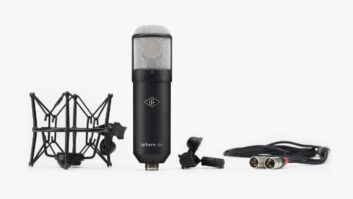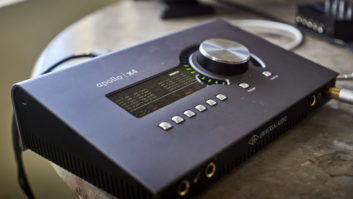
Bill Putnam founded Universal Audio with the idea that his designs would be synonymous with technical and sonic quality, and the UA design team has forged Putnam’s ideas into their latest offering, the Apollo High Resolution Interface with UAD-2 processing. Apollo offers many features, including mic/line inputs, a range of outputs, monitoring, a software console and more. The QUAD version reviewed here has four processors, while the DUO has two. UA gear has been a part of my studio and projects since I started working, so I looked forward to recording and mixing with Apollo.
Inside and Out
The Apollo is a single-rackspace unit with an external global power supply (110 /240 volts, 50 /60 Hz) that connects via a multipin XLR connector, then an IEC cable into the wall. It comes with 32- and 64-bit device drivers for use with the latest DAW software. I loaded the software on both my Mac Pro tower and MacBook Pro laptop and was quickly up and running using the dual FireWire 800 ports on the back of the unit. Should you not have a FireWire 800 port, UA suggests several manufacturers that make affordable cards that integrate well with Apollo.
There are eight analog inputs (four XLR mic, eight TRS 1⁄4-inch line, the first four are shared), eight analog outs (TRS 1⁄4-inch) and eight digital optical I/Os via ADAT. S/MUX provides eight I/Os at sample rates up to 96 kHz and four I/Os at 176.4 and 192k. Two S/PDIF coaxial ins and outs will do automatic sample-rate conversion if the source isn’t matching. The Apollo has no MIDI connections.
The front panel controls the four XLR analog inputs: a simple push on the knob switches from one mic input to the next. The control knob will boost gain up to 65 dB, making it ribbon friendly, and the first two analog inputs can also be purposed for instruments. Other features include a highpass filter button, reverse polarity, phantom power and a linking option for the mic preamps. There is also monitor control for the stereo and headphone outs and 10-step LED meters for the eight analog inputs and stereo outs.
Looking inside Apollo QUAD reveals four SHARC processors, which are the same chips offered in the other UAD-2 products. Apollo can be combined with other UAD-2 devices for even more DSP. All plug-ins are available in RTAS, VST and Audio Units formats.
Apollo Software
Apollo is able to run all UAD-2 plug-ins that are authorized in your personal UA account—no iLoks or dongles are required. It comes with a software console that looks very similar to one of Putnam’s early designs. The console’s recall feature allows you to save favorite channel settings, tracking setups and monitoring situations and quickly pull them into a new session. You can then choose to commit to the sounds of the plug-ins or simply monitor them when recording with almost no recognizable latency. Yes, I said record through the plug-ins! After installing the software on the MacBook Pro, I pulled up a new session in Pro Tools and it quickly recognized the hardware unit. I opened the console and was ready to record.
Pro Tools has long been my DAW of choice, but Apollo worked well with Logic and Ableton Live. I asked two remixer/DJ friends how Apollo would help their workflow, and they both commented that they love the idea of having a stable, separate unit for processing and monitoring in a live setting that is not reliant on the computer. They also liked the idea of being able to process tracks in real-time and recall console settings in the studio or at a gig—all within in a single-space unit. Their only complaint was that the Apollo lacks MIDI connections.

Recording With Apollo
My first session involved recording and mixing everything on a laptop. I recently started a new record with Nashville’s Kyle Andrews where we wanted to blend live performance and retro sounds with modern synths and production. We recorded drums, bass, acoustic and nylon string guitars, organ, percussion and vocals all through the Apollo’s preamps with stunning results. The quieter sound sources were no problem for Apollo’s preamps, which offered plenty of clean gain. Kyle commented that he loved being able to set up his own mix against what I was hearing, using the aux sends on the console.
We recorded the tracks once with no processing, then a second time with plug-ins for comparison. I have access to all of UA’s plug-ins, but users can also demo any of them for a short time to find favorites. Decisions, decisions: Drums through a Neve 1073, Harrison 32 or Helios 69 pre? An 1176 on every channel? SSL processors to mix? The EMT 140 and 250 plates are easily my favorite reverb replications, and Kyle was going bananas tinkering with the Roland Space Echo. We even did some processing of the drums through a Fairchild and sent them back into two channels through the TRS outputs and inputs on the back of the unit. I found myself wishing for a quick command to drag and drop a plug-in or setting, which would be a real time-saver. The recording went quickly and flawlessly, and we were inspired to start mixing right away. Monitoring through the Apollo was very accurate and I was able to quickly put together a concise mix. The only thing I felt was missing was a master bus insert to get the mix exactly the way I wanted, but UA points out that this would add latency to the output so the company recommends using a master plug-in in the DAW.
I then used Apollo with my Pro Tools|HD system and Mac Pro tower rig, which increased my processing power. I mixed a project for Dave Matthews Band saxophonist Jeff Coffin, who wanted it to sound “analog,” like an old ’50s or ’60s Blue Note recording. I employed several tape machine emulation plug-ins across different parts of the mix and the EMT 140 plate on his sax. Jeff responded with, “Sounds great, print it!” Even the mastering engineer commented on how the mixes sounded very warm and analog.
Next, I mixed a project for legendary songsmith JD Souther. This was a live project, and JD wanted to feel like he was sitting in the room while listening back. He loved the flexibility of Apollo and being able to compare plug-ins’ effects on the overall mix.
The Apollo compared nicely to my UA 2192 converters when recording drums, percussion, and electric guitars at different sample rates. At higher sampling rates I heard bit of a difference in vocals and top-end transients from instruments, and preferred the 2192. When converting audio through Apollo, it sounded great, but when bouncing mixes, the 2192 still felt a little bigger, wider and punchier.
Complete Package
My expectations for Apollo were very high, but after recording, mixing and monitoring through the unit, UA’s introduction to the audio interface market proved worthy of the brand. The unit is powerful and flexible, and it sounds fantastic. It allows the user to get up and running quickly and focus on making inspired recordings. That’s what I look for in any piece of gear, and Apollo offers that and more. If you’re looking to expand your processing power, simplify your workflow or have a super portable interface that sounds great, look no further than Apollo. n
Chris Grainger (itsgrainger.com) is a producer/mixer/engineer and owner of Undertow Studio in Nashville, Tenn.
TRY THIS
Record a drum set through Apollo’s mic pre’s alone or through various plug-ins to get the sound you desire. Then send a stereo mix of the tracks out of the Apollo using the TRS ¼-inch I/O on the back, then back into Apollo to re-record them onto two new tracks. Apply an 1176 of your choice to the new tracks and set it to an aggressive setting from the presets. Mix this new track into your original kit to achieve a bigger sound than you had before.
PRODUCT SUMMARY
COMPANY: Universal Audio
PRODUCT: Apollo
WEBSITE:uaudio.com
PRICE: QUAD $2,999; DUO $2,499
PROS: Real-time processing. Easy-to-use console interface.
CONS: No MIDI input.







